[ad_1]
Okay, so the 6.1-inch screen on the Samsung Galaxy S23 isn’t exactly tiny compared to the 4.7-inch display on the Apple iPhone SE, or the displays on mid-range Android devices like the 5.9-inch Asus Zenfone 9. Not to mention the 3-inch Unihertz Jelly Phone 2. But the Galaxy S23 is one of the smallest Android flagships you can buy right now, and thankfully, it’s also one of the most feature-filled.
The Galaxy S23+ is also a gem, with its slightly larger 6.6-inch display. Samsung improved the camera algorithms on both devices, so it doesn’t feel like you’re settling by not picking the Ultra—or a Pixel. And while Samsung’s OneUI can feel a little aggressive compared to Google’s version of Android, it comes with perks like Bixby Voice Text and stacked widgets.
A Samsung display that will fit in your pocket

Samsung’s Galaxy S23 has a 6.1-inch display, while the Galaxy S23+ has a 6.6-inch display. Both devices are Super AMOLED with a FullHD+ resolution and a 120Hz variable refresh rate. That’s quite the specification, considering the Pixel 7’s 90Hz refresh rate—it’s acceptable for everyday use, but there’s a smoothness to Samsung’s display when scrolling through webpages and flicking Poké balls in Pokémon Go that’s not present on Google’s smaller device. The Samsung Galaxy S23/23+ is also brighter than the Pixel 7 and Pixel 7 Pro by about 200 nits at maximum brightness.
Remember that buying a Samsung smartphone means carrying around a mini advertisement for the company’s display technology, which is in way more than its phones. That’s not a bad thing, as Samsung makes some of the best TVs and other displays in the industry. Indeed, the color balance and vibrancy here are the same as on the Galaxy S23 Ultra, whether you’re on the smaller Galaxy S23 or S23+. And while the Galaxy S23 has a smaller display than the Pixel 7’s, the colors are much more vibrant on Samsung’s side, with bluer blues and whiter whites. The latter of those can appear yellow-hued on the Pixel.
I was struck by how much presence the Galaxy S23’s stereo speakers had when i turned up the volume. There is a speaker at the bottom of the device and one facing upward at the top. I listened to typically bass-heavy genres like classic techno and synthwave without headphones, and Samsung’s little phone felt full-bodied each time. It’s not enough to fill up a room for an impromptu dance session, but it’s great for sharing a YouTube video or a new song with a friend sitting beside you.
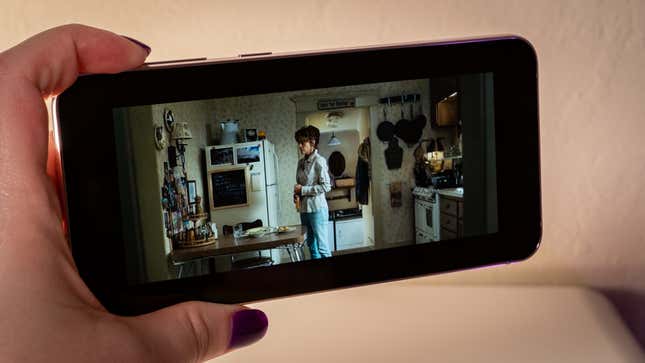
Looks very similar to the Samsung S23 Ultra
Samsung tweaked the design of the Galaxy S23/S23+ since last year’s release. If you didn’t like the camera island on the Galaxy S22 and the model preceding it, the good news is that it’s gone in this generation. There is now more design parity across all three of Samsung’s flagship offerings. When you look at any of the Galaxy S23 phones from the back, you’ll know it’s a Samsung device—the same way you can tell if someone is using an Apple iPhone by its stove-top camera configuration or the Google Pixel by its signature camera bar.
Samsung’s color offerings for the Galaxy S23/S23+ are the same across the board: graphite, cream, green, lime, lavender (which appears more pinkish in person), and black. The gray graphite colorway and lime are only available if you buy the smartphones online, so keep that in mind when shopping. Still, it’s an excellent spectrum of color offerings from Samsung.
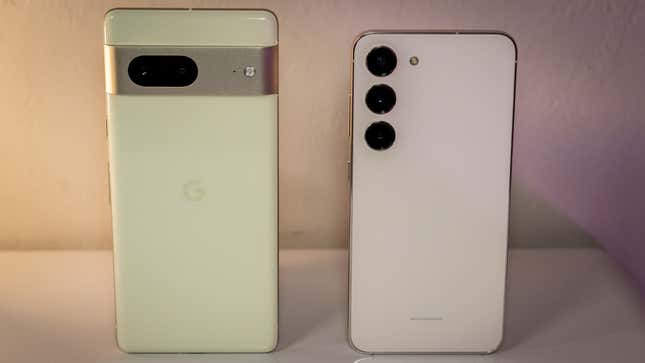
The Galaxy S23/S23+ are IP68 rated for dust and water resistance, which means they can handle full submersion for 30 minutes. They’re enforced with Gorilla Glass Victus 2 panels on the front and backside and have an aluminum chassis. And yet, unlike Apple’s iPhone 14 Pro (which weighs 7.2 ounces), they do not feel like solid metal slabs. They’re pretty light to hold—the Galaxy S23 is 5.9 ounces and the Galaxy S23+ is 6.8 ounces—but there’s a hollowness when I use my fingernail to tap on their backsides that makes the phones feel somewhat chintzy. The Google Pixel 7 has a bit of that going on, too, and I wonder if this is just my penance for being an Android user (that’s a joke, don’t @ me).
The unlocking methods on the Galaxy S23/S23+ are standard affairs. I found the on-display fingerprint unlock to be faster than the Pixel 7’s. The facial unlock was quick, too, and a helpful little icon at the top of the lock screen indicates whether the camera sees you or not.

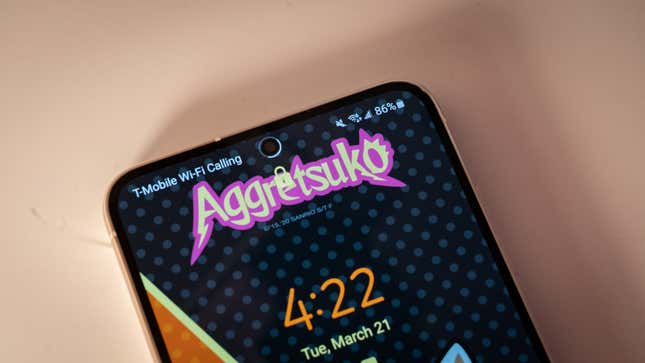
The Galaxy S23 doesn’t need to be ultra to be powerful
The Galaxy S23/S23+ runs on the same processor as the Galaxy S23 Ultra: the Qualcomm Snapdragon 8 Gen 2 for Galaxy chip. Both smartphones are only available with 8GB of RAM, versus the Ultra’s option for 12GB. The Galaxy S23 tops out at 256GB of storage, and the Galaxy S23+ goes up to 512GB. Only the former is available with 128GB of storage, but that variant uses Universal Flash Storage (UFS) version 3.1 versus the current standard of UFS 4.0. This ultimately means that, in some instances, it will take longer for data to write, which means experiencing a moment between when you’re shooting a photo and when it’s safely filed away.
Between reviewing the Galaxy S23 Ultra and the regular Galaxy S23/S23+, Geekbench updated its app to version 6. As a result, the scoring differs from what we saw with Geekbench 5. I did run a few Geekbench 6 tests to see how the Galaxy S23 series performs against last year’s Pixel 7/7 Pro, and the 8GB Galaxy S23/S23+ is only a little faster than Google’s Tensor G2—about 100 points faster in the single-core score and nearly 2000 points in the multi-core score. Since this is a Samsung-optimized chip for Samsung devices, performance should be solid across the board.
This year’s OnePlus 11 manages two to three more hours of screen time than these two Samsung devices. In our rundown test, which constantly streams video at 200 nits, the Galaxy S23’s 3,900 mAh battery lasted only 16 hours and 49 minutes, and the Galaxy S23+’s 4,700 mAh battery petered out at precisely 18 hours. The best phones currently last about 20 hours or more off the charger, which the OnePlus 11 (and the iPhone 14 Pro) does. We saw similarly disappointing numbers with the gargantuan Galaxy S23 Ultra’s 6.8-inch display and 5,000 mAh battery, but I was hoping these smaller variants would have more juice.
Galaxy S23’s camera is good, but not as good as the Pixel 7’s
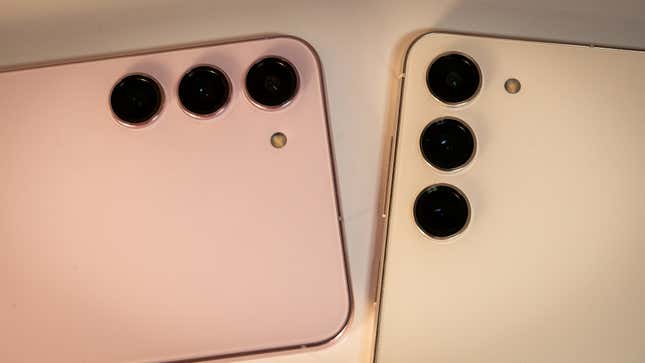
While there are differences in color temperature and post-processing between the Galaxy S23 and its immediate rival, the Pixel 7, Samsung’s side has gotten much less aggressive and more naturalistic over time. I compared these two models during my testing because I was curious about what I’d give up by choosing Samsung’s camera system over Google’s algorithms.
The Galaxy S23/S23+’s camera system includes a 50-MP primary camera, a 12-MP ultrawide camera, and a 10-MP telephoto lens with optical image stabilization, 3x optical zoom, and up to 30x “space zoom.” Do not buy the Galaxy S23/S23+ if you care about zooming to extreme distances, because the picture will start to fuzz up as you pass the optical zoom threshold. If you want good zoom on an Android smartphone, spend the money and get the Galaxy S23 Ultra instead.

For everyday situations, I generally liked the photos I took with the Galaxy S23. Images are sharp, vibrant, and well-toned. I was pleased to see it was competent at dusk, when the golden hour hits and the world looks dreamy. Smartphones can’t always capture the essence of the sky because of over-processing, but the Galaxy S23 managed to keep it at a rate that I didn’t feel like I was missing out on the moment. Sunset is also where I started to see the differences between the Galaxy S23 and the Pixel 7 more clearly. Google’s version is warmer and brighter, while Samsung’s still skews almost artificially blue (something I complained about in last year’s reviews). It also tends to oversharpen the final product to reduce noise, especially when zooming in.
You won’t miss out on nighttime shots with the Galaxy S23/S23+. The two smartphones almost perform to parity with the Pixel 7 if you’re shooting inside a bar or a dark restaurant. Samsung’s low-light images are darker, with more intense contrast in the shadows, whereas Google is aggressive about lighting the photo to enhance detail. But this is also why the Pixel’s nighttime landscape photography sometimes results in a slightly artificial, washed-out look. I’m keener on Samsung’s results. An example: Using Samsung’s phone, I could actually see the red lights on the windmills in the distance in the below photo sample.

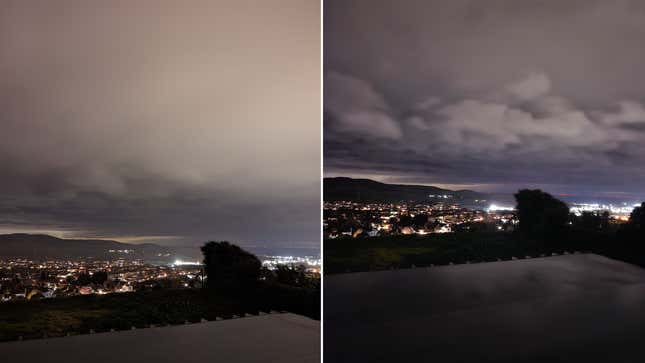
The Galaxy S23/S23+ has the same video-capturing capabilities as the Galaxy S23 Ultra sibling. They can shoot up to 8K resolution at 30fps, 4K resolution at 60fps, and full HD at 120fps. In addition to a standard slow-motion (captured at 240 fps), there’s a super slow-mo (captured at 960 fps). For most cases, the latter felt like overkill, but it’s there if you want to make a cool video of a hummingbird or bee. I’m a little creeped out that Samsung takes slow-motion photos with the volume intact though. I prefer the Pixel 7’s take on this feature, which mutes the sound in the result. Seriously, have you ever heard a swing set screech at 960fps? It’s cursed.
The front-facing camera on the Galaxy S23/S23+ is a 12-MP camera with wide-angle capabilities. I took selfies and recorded confessional TikToks, and it was fine. I prefer the result on the Samsung front-facing camera to the Pixel 7’s front-facing camera, as the latter is aggressive in softening the image in low-light settings. (This concern has been sprouting up in forums recently.) I also like Samsung’s filtering capabilities. They’re more subtle than they used to be, so I don’t feel like people will call me out for digitally smoothening my face and elongating my chin. I am tired; it is my right to use a filter to feel better about myself.
Samsung’s Android is not quite Google’s
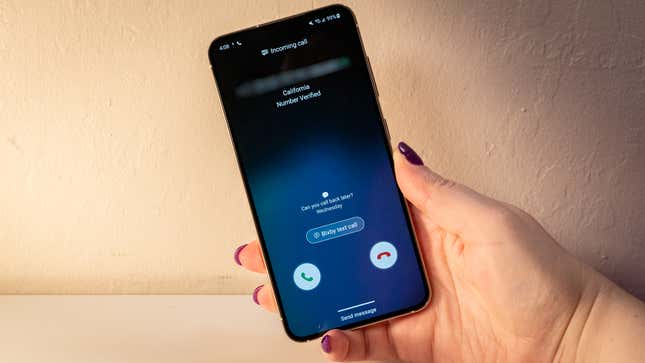
Samsung has been a much better Android player since it expanded its update policy. The Galaxy S23/S23+ will get four OS updates, meaning you’ll have the latest version of the software up until Android 17, plus five years of security updates. Despite setting a precedent for the platform, Google only offers three OS updates for each phone its Pixel lineup.
But Samsung’s version of Android differs slightly from Google’s (and OnePlus’s, for that manner). The Galaxy S23/S23+ runs OneUI 5.1, a skin on top of Android 13. It brings features like stacked widgets on the home screen and an image clipper that can copy the main subject and share it elsewhere, akin to the feature on iOS 16. It also offers animated lock screens you can make from a video clip, which parents of humans and pets alike will enjoy for the occasional serotonin boost. Overall, OneUI is an amalgamation of the features Android users would like to have from Apple’s iOS, with sprinkles of Google’s vision for its platform.
Bixby is also still alive. I finally received the software update that enables Bixby Text Call, and it’s the most curious of OneUI’s new capabilities. It converts typed messages into speech. When the phone rings, you can select the option to interface with Bixby Text Call. You can choose from a bundle of preset choices or type out your response. I tried it with a friend, and it works like a text-to-speech app. You can have a conversation this way for a while if you like, but the point of the feature is to help you call without disrupting your current environment. My friend on the other line thought it was “weird.”
The Galaxy S23 is a fine alternative to the Pixel 7

There is one major reason why I will not be trading in my current Pixel 7 for a Galaxy S23, even though I prefer Samsung’s smaller chassis size. The Galaxy S23 does not have ultra wide-band (UWB) support, which is one of the reasons I dinged the smaller Galaxy S22 last year. I am on a carrier that utilizes that particular spectrum and would like to continue reaping the benefits of my costly monthly bill.
In another timeline, Samsung has made UWB available on the smallest Galaxy S23, and I finally have a phone that can fit into my pockets and small clutches without dragging me down. The nice thing about Samsung’s flagships this year is that there are no significant tradeoffs for the Android experience or the camera capabilities. It’s up to you if you prefer Samsung’s flavor of Android.
[ad_2]


